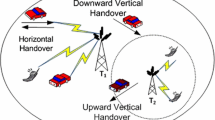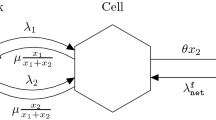Abstract
In this paper, we discuss views concerning different approaches to the analysis of personal communication systems (PCSs): an outside observer's point of view, a user's point of view, and a base station's point of view. In these three approaches the paper focuses on the handover mechanism rather than on the data traffic modeling. In particular, we reexamine these different methods of analysis, combine these views with our approach, and propose a new queueing model. We take into account the speed factor and show that the ordinary measurements that are based on the state probabilities are not appropriate. In addition, we propose a layered queueing model in which low-speed and high-speed users are treated differently.
Similar content being viewed by others
References
David J. Goodman, Cellular packet communications,IEEE Transactions on Communications, Vol. 38, No. 8, pp. 1272–1280, 1990.
Jerry L. Grubb, The traveller's dream come true,IEEE Communications Magazine, Vol. 29, No. 11, pp. 48–51, 1991.
Max M.-K. Liu, Base station networking in personal communications,Proceedings Globecom, pp. 1912–1916, 1991.
Sirin Tekinay and Bijan Jabbari, A measurement-based prioritization scheme for handovers in mobile cellular networks,IEEE Journal on Selected Areas in Communications, Vol. 10, No. 8, pp. 1343–1350, 1992.
Sirin Tekinay and Bijan Jabbari, Handover and channel assignment in mobile cellular networks,IEEE Communications Magazine, Vol. 29, No. 11, pp. 42–46, 1991.
Noach Amitay, Distributed switching and control with fast resource,IEEE Journal on Selected Areas in Communications, Vol. 11, No. 6, pp. 842–849, 1993.
J. C. L. Chuang, Performance limitations of TDD wireless personal communications with asynchronous radio ports,Electronics Letters, Vol. 28, No. 6, pp. 532–534, 1992.
Leandro Rocha Maciel, Henry L. Bertoni, and Howard H. Xia, Unified approach to prediction of propagation over buildings for all ranges of base station antenna height,IEEE Transactions on Vehicular Technology, Vol. 42, No. 1, pp. 41–45, 1993.
Masahiro Morikura, Shigeki Nitta, Katsuhiko Kawazoe, Hiroshi Kazama, and Shuzo Kato, Semi-autonomous synchronization for TDMA-TDD communication system. Proceedings of the 43rd IEEE Conference on Vehicular Technology, pp. 297–300, 1993.
R. Steele and M. Nofal, Teletraffic performance of microcellular personal communication,IEE Proceedings, Part I: Communications, Speech and Vision, Vol. 139, No. 4, pp. 448–461, 1992.
Chong Ho Yoon and Chong Kwan Un, Performance of personal portable radio telephone systems with and without guard channels, IEEE International Conference on Communications, Geneva, pp. 1947–1951, 1993.
Author information
Authors and Affiliations
Rights and permissions
About this article
Cite this article
Toloo, M., Mouftah, H.T. Handover mechanism and speed considerations in personal communication systems. Int J Wireless Inf Networks 3, 79–88 (1996). https://doi.org/10.1007/BF02107049
Issue Date:
DOI: https://doi.org/10.1007/BF02107049




